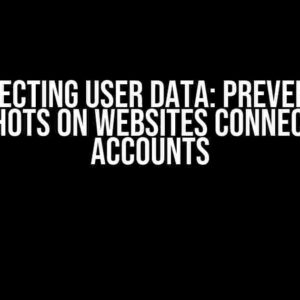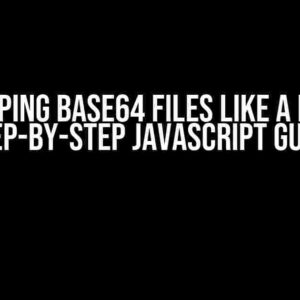Are you tired of dealing with mysterious Chrome extensions that slow down your browser? Do you want to take control of your online experience and ensure that only trusted extensions have access to your data? Look no further! In this comprehensive guide, we’ll delve into the world of Chrome extension detection, focusing on the fully loaded tab. Buckle up, and let’s get started!
What is the Fully Loaded Tab in Chrome Extension Detection?
The fully loaded tab is a crucial component of Chrome extension detection, allowing developers to inspect and analyze the content of a webpage after all resources have finished loading. This tab provides a detailed breakdown of the webpage’s structure, resources, and network requests, giving developers the insights they need to detect and debug issues related to Chrome extensions.
Why is the Fully Loaded Tab Important for Chrome Extension Detection?
The fully loaded tab is essential for Chrome extension detection because it allows developers to:
- Identify performance bottlenecks: By analyzing the webpage’s resource loading times, developers can pinpoint extension-related performance issues.
- Detect malicious activity: The fully loaded tab helps developers identify suspicious network requests or resource loading patterns that may indicate malicious extension activity.
- Optimize extension performance: By analyzing the webpage’s structure and resource loading, developers can optimize their extensions to improve performance and reduce latency.
How to Access the Fully Loaded Tab in Chrome Extension Detection
To access the fully loaded tab, follow these steps:
- Open Google Chrome and navigate to the webpage you want to analyze.
- Press
F12or right-click on the webpage and selectInspect. - In the Chrome DevTools window, switch to the
Elementstab. - Click on the
Elementstab’sElementsdropdown menu and selectFull page load. - Wait for the webpage to fully load, and then switch to the
Networktab. - In the
Networktab, select theFULLfilter option.
Understanding the Fully Loaded Tab’s Interface
The fully loaded tab’s interface is divided into several sections, each providing valuable insights into the webpage’s structure and resource loading:
| Section | Description |
|---|---|
| Request Table | Displays a list of all requests made by the webpage, including resource loading times and sizes. |
| Resource List | Provides a breakdown of all resources loaded by the webpage, including HTML, CSS, JavaScript, and image files. |
| Timeline | Visualizes the webpage’s resource loading timeline, highlighting performance bottlenecks and areas for optimization. |
| Headers | Displays HTTP headers for each request, including request and response headers. |
Using the Fully Loaded Tab for Chrome Extension Detection
Now that you’re familiar with the fully loaded tab’s interface, let’s explore how to use it for Chrome extension detection:
Identifying Extension-Related Requests
To identify extension-related requests, follow these steps:
- In the Request Table, sort requests by
Initiator. - Look for requests with an
Initiatorvalue starting withchrome-extension://, which indicates that the request is related to a Chrome extension. - Analyze the request’s
Request URL,Request Method, andResponse Codeto determine the purpose of the request.
Detecting Malicious Activity
To detect malicious activity, follow these steps:
- In the Request Table, sort requests by
Response Code. - Look for requests with unusual or suspicious response codes, such as
403 Forbiddenor500 Internal Server Error. - Analyze the request’s
Request URLandRequest Methodto determine if it’s related to a Chrome extension.
Optimizing Extension Performance
To optimize extension performance, follow these steps:
- In the Timeline, identify performance bottlenecks and areas for optimization.
- Analyze the Resource List to determine which resources are taking the longest to load.
- Optimize resource loading by minimizing requests, compressing files, and leveraging caching.
Best Practices for Chrome Extension Detection using the Fully Loaded Tab
To get the most out of the fully loaded tab for Chrome extension detection, follow these best practices:
- Use the fully loaded tab in conjunction with other Chrome DevTools, such as the Elements tab and the Console tab, to gain a comprehensive understanding of the webpage’s structure and behavior.
- Regularly monitor extension-related requests and resource loading to detect potential issues and optimize performance.
- Use the fully loaded tab to test and debug your own Chrome extensions, ensuring that they’re performing as intended.
Conclusion
In conclusion, the fully loaded tab is a powerful tool for Chrome extension detection, providing developers with valuable insights into the webpage’s structure and resource loading. By following the steps and best practices outlined in this guide, you’ll be well on your way to detecting and debugging Chrome extension-related issues, and optimizing extension performance. Remember to stay vigilant and continually monitor your extensions to ensure a safe and secure browsing experience.
Code snippet:
// Example Chrome extension code snippet
chrome.browserAction.onClicked.addListener(function(tab) {
chrome.tabs.executeScript({
code: "console.log('Hello, world!');"
});
});
With the fully loaded tab and these best practices, you’re ready to take your Chrome extension detection skills to the next level!
Frequently Asked Questions
Get all your queries about Chrome Extension detection tab fully loaded answered right here!
What is the Chrome Extension detection tab fully loaded?
The Chrome Extension detection tab fully loaded is a feature that allows developers to detect when a web page has finished loading all its resources, including images, scripts, and other assets. This ensures that the extension can accurately interact with the page’s content without any issues.
Why is it important to detect when a tab is fully loaded?
Detecting when a tab is fully loaded is crucial because it allows your extension to perform actions that rely on the page’s content, such as data extraction, content modification, or automation. Without this detection, your extension might end up interacting with incomplete or changing page content, leading to errors or unwanted behavior.
How does the Chrome Extension detection tab fully loaded work?
The Chrome Extension detection tab fully loaded works by listening to the `tabs.onUpdated` event, which fires when a tab’s status changes. When the tab’s status changes to `complete`, the extension can assume that the page has finished loading and is ready for interaction. Additionally, the extension can also use the `webNavigation.onDOMContentLoaded` event to detect when the initial HTML document has finished loading.
Can I use the Chrome Extension detection tab fully loaded for content scripts?
Yes, you can use the Chrome Extension detection tab fully loaded with content scripts. In fact, it’s a great way to ensure that your content script runs only after the page has finished loading, allowing you to accurately interact with the page’s content. Simply inject your content script into the page and listen for the `tabs.onUpdated` or `webNavigation.onDOMContentLoaded` event to detect when the page is fully loaded.
Are there any limitations or considerations when using Chrome Extension detection tab fully loaded?
Yes, there are some limitations and considerations when using Chrome Extension detection tab fully loaded. For example, the `tabs.onUpdated` event might not fire in certain situations, such as when the user navigates away from the tab or closes the browser. Additionally, the `webNavigation.onDOMContentLoaded` event might fire multiple times if the page reloads or navigates to a new URL. Be sure to handle these edge cases and test your extension thoroughly to ensure reliable behavior.





